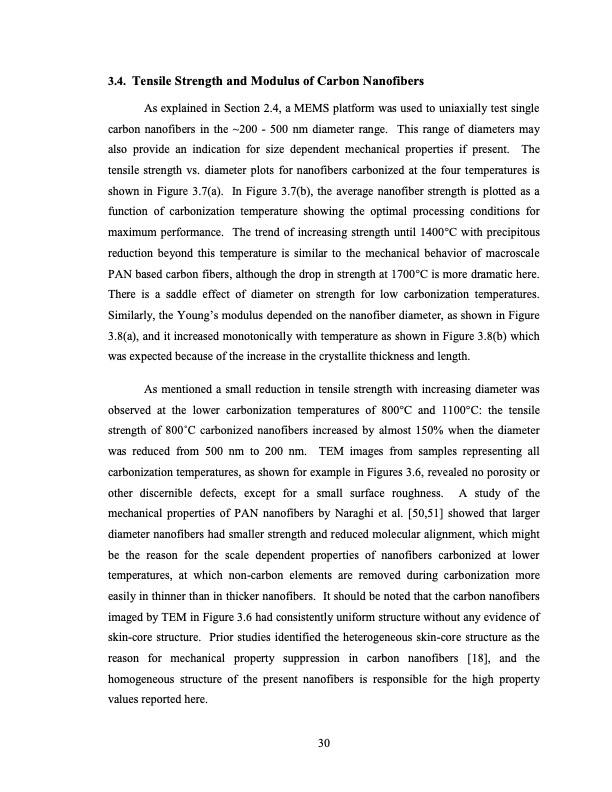
PDF Publication Title:
Text from PDF Page: 037
3.4. Tensile Strength and Modulus of Carbon Nanofibers As explained in Section 2.4, a MEMS platform was used to uniaxially test single carbon nanofibers in the ~200 - 500 nm diameter range. This range of diameters may also provide an indication for size dependent mechanical properties if present. The tensile strength vs. diameter plots for nanofibers carbonized at the four temperatures is shown in Figure 3.7(a). In Figure 3.7(b), the average nanofiber strength is plotted as a function of carbonization temperature showing the optimal processing conditions for maximum performance. The trend of increasing strength until 1400°C with precipitous reduction beyond this temperature is similar to the mechanical behavior of macroscale PAN based carbon fibers, although the drop in strength at 1700°C is more dramatic here. There is a saddle effect of diameter on strength for low carbonization temperatures. Similarly, the Young’s modulus depended on the nanofiber diameter, as shown in Figure 3.8(a), and it increased monotonically with temperature as shown in Figure 3.8(b) which was expected because of the increase in the crystallite thickness and length. As mentioned a small reduction in tensile strength with increasing diameter was observed at the lower carbonization temperatures of 800°C and 1100°C: the tensile strength of 800 ̊C carbonized nanofibers increased by almost 150% when the diameter was reduced from 500 nm to 200 nm. TEM images from samples representing all carbonization temperatures, as shown for example in Figures 3.6, revealed no porosity or other discernible defects, except for a small surface roughness. A study of the mechanical properties of PAN nanofibers by Naraghi et al. [50,51] showed that larger diameter nanofibers had smaller strength and reduced molecular alignment, which might be the reason for the scale dependent properties of nanofibers carbonized at lower temperatures, at which non-carbon elements are removed during carbonization more easily in thinner than in thicker nanofibers. It should be noted that the carbon nanofibers imaged by TEM in Figure 3.6 had consistently uniform structure without any evidence of skin-core structure. Prior studies identified the heterogeneous skin-core structure as the reason for mechanical property suppression in carbon nanofibers [18], and the homogeneous structure of the present nanofibers is responsible for the high property values reported here. 30PDF Image | HIGH STRENGTH CARBON NANOFIBERS DERIVED FROM ELECTROSPUN POLYACRYLONITRILE

PDF Search Title:
HIGH STRENGTH CARBON NANOFIBERS DERIVED FROM ELECTROSPUN POLYACRYLONITRILEOriginal File Name Searched:
4835609.pdfDIY PDF Search: Google It | Yahoo | Bing
Sulfur Deposition on Carbon Nanofibers using Supercritical CO2 Sulfur Deposition on Carbon Nanofibers using Supercritical CO2. Gamma sulfur also known as mother of pearl sulfur and nacreous sulfur... More Info
CO2 Organic Rankine Cycle Experimenter Platform The supercritical CO2 phase change system is both a heat pump and organic rankine cycle which can be used for those purposes and as a supercritical extractor for advanced subcritical and supercritical extraction technology. Uses include producing nanoparticles, precious metal CO2 extraction, lithium battery recycling, and other applications... More Info
| CONTACT TEL: 608-238-6001 Email: greg@infinityturbine.com | RSS | AMP |